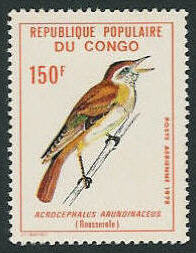The Dutch population of the Great Reed Warbler Acrocephalus arundinaceus has declined by 90% from 1960 to 1990 (from 5,000 breeding pairs in 1950-1960 to 400-550 in 1989-1991), and continued to decline by 6% per annum since 1990. The territories of a large Great Reed Warbler colony in the shallow Reeuwijk lakes (at 52◦2’ N and 4◦45’E in the Western part of the Netherlands, near Gouda), which originated from peat-digging in the 16th and 17th century, decreased from 90-100 in 1975, 40 in 1993, 20 in 1997, 14 in 2000, 8 in 2004 to just 6 in 2005. The Reeuwijk polder is mainly used for agriculture and surplus water during wet periods is discharged via the Reeuwijk lakes to the Breevaart canal, which may expose insects in the Reeuwijk lakes to surface water contaminated with pesticides. Surface water analyses in the vicinity of the Reeuwijk lakes have revealed excessively high concentrations of imidacloprid and carbamates (carbendazim and propoxur) that are bound to be toxic to insects. There is supporting evidence. Monitoring data for the characteristic dragonfly Aeshna viridis (a food source for the Great Reed Warbler) in the Reeuwijk lakes since 1998 indicate that this population is declining. The populations of other dragonflies characteristic of peat bogs in the Netherlands, i.e. Leucorrhinia pectoralis (large white faced darter) and Sympecma paedisca are also in decline since the 1960s.
Sources:
Cramp S (1992) The birds of the western Paleartic,4. Oxford University Press, Oxford
Hagemeijer WJM and Blair MJ (1997) The EBCC Atlas of European breeding birds: their distribution and abundance. T&AD Poyser, London
Tucker GM and Heath MF (1994) Birds in Europe: their conservation status. Birdlife International, Cambridge, UK
Ministerie Landbouw, Natuur en Voedselkwaliteit (Dutch Ministry of Agriculture, Nature and Food Quality). Vogelrichtlijnsoorten:Grote Karekiet [A298]
Dijk AJ van et al. (2003). Kolonievogels en zeldzame broedvogels in Nederland in 2002. SOVON-monitoringrapport 2003/02. SOVON Nederland. Beek-Ubbergen
Dijk AJ van et al. (2009). Broedvogels in Nederland in 2007. SOVON-monitoringrapport 2009/01. SOVON Vogelonderzoek Nederland, Beek-Ubbergen
Heikoop L (2002) De Grote Karekiet (Acrocephalus arundinaceus) in het Reeuwijkse Plassengebied: ontwikkeling, biotoopeisen en beheersmaatregelen. Waardvogel 2002, nr 2. Natuur- en Vogelwerkgroep Krimpenerwaard
SOVON: Nieuws uit de provincie Zuid-Holland 2005/2 oktober & SOVON: Nieuws uit de provincie Zuid-Holland 2006/1 maart, SOVON Vogelonderzoek Nederland, Beek-Ubbergen, The Netherlands
Hoogheemraadschap van Rijnland (2010). Schoon water in de Reeuwijkse Plassen, www.rijnland.net
De Vries HH en Ketelaar R (2003) De groene glazenmaker in Zuid-Holland. Rapport VS2003.18, De Vlinderstichting, Wageningen.
Ministerie Landbouw, Natuur en Voedselkwaliteit (Dutch Ministry of Agriculture, Nature and Food Quality). Habitatrichtlijnsoorten: Gevlekte witsnuitlibel [H1042]
Kalkman VJ (2004) Noordse winterjuffer Sympecma paedisca (Brauer 1877), EIS-Nederland, Leiden

- Login om te reageren
